Iraq is a Middle Eastern country that borders the Persian Gulf. The major river systems of the Tigris and Euphrates flow through Iraq and form the Mesopotamian marshes before emptying into the Gulf. Many large and small lakes dot the country’s landscape, including the largest lake, Lake Tharthar, located northwest of the capital of Baghdad. The rivers, lakes, marshes, and seas of Iraq provide homes to a wide variety of fish species. From fish used to make the national dish to unique fish found off the coast in the coral reef, read on to find out all about eight spectacular fish found in Iraq!
1. Common Carp
Let’s start with one of the most spectacular-tasting fish! The carp is the main ingredient of the national dish of Iraq, Masgouf. Masgouf is a grilled seasoned carp that is popular in many restaurants, especially in the capital. Many of the carp used as food fish are from fish farms, but they naturally populate the Tigris-Euphrates River Basins. Common carp are heavy-bodied fish that can get to be 47 inches long and weigh 88 pounds, but they average closer to 14 inches long. They have a bronze coloration and very distinct scales along their sides. You can see two barbels on each side of the upper part of their mouth. They prefer to live at the bottom of lakes and slow-moving rivers.

The common carp is the main ingredient of the national dish of Iraq, Masgouf.
©Rostislav Stefanek/Shutterstock.com
2. Mangar (Pike Barbel)
One of the largest fish in the Euphrates River is the Mangar or pike barbel. They can reach lengths of 7-7 ½ feet and weigh nearly 300 pounds! They are in the same fish family as carp, the cyprinid family. Mangar are long and narrow fish with silvery scales and a lighter underside. Their snout is more pointed similar to that of a pike. However, instead of a mouth full of needle-like teeth like the Northern pike, the Mangar has no teeth. As a result, they are able to suck up their prey and swallow it whole! Kind of an impressive fish!
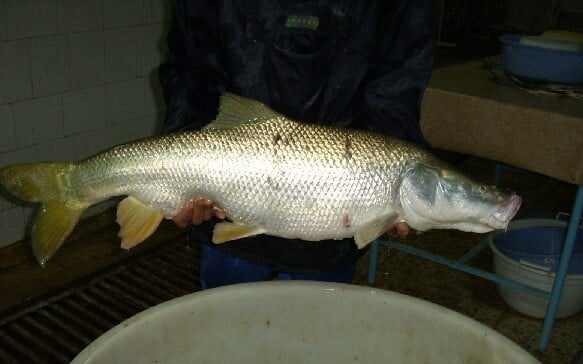
One of the largest fish in the Euphrates River is the Mangar or pike barbel.
©maleek silawi, CC BY 3.0 <https://creativecommons.org/licenses/by/3.0>, via Wikimedia Commons – License
3. Yellowfin Barbell
The yellowfin barbell is one of the fish that call Lake Tharthar, the largest lake in Iraq, their home. They also live in the Tigris-Euphrates River system, preferring the bottom of the lake and rivers. Yellowfin barbells are in the same family as the mangar and carp, the cyprinid family. They are long, narrow fish with heavy scales and a forked tail. Most are a silvery-gray color with yellowish fins, including a tall triangular dorsal fin. The ecosystem in and around Lake Tharthar is an important watering hole for grazing animals and migrating birds. Besides the yellowfin barbell, there are also common carp, catfish, and mullets living in Lake Tharthar.

Yellowfin barbells are in the same family as the mangar and carp, the cyprinid family.
©Seyed Abdolsaheb Mortezavizadeh, CC BY 3.0 <https://creativecommons.org/licenses/by/3.0>, via Wikimedia Commons – License
4. Arabian Yellowfin Seabream
Iraq is one of eight countries that border the Persian Gulf. While Iraq certainly doesn’t have a long Gulf coastline, it provides many benefits compared to being landlocked. One of the commonly marketed fish from the Persian Gulf is the Arabian yellowfin seabream. These seabreams are metallic silver in color with a spiked dorsal fin and yellow pelvic fins. They typically don’t get larger than 13.7 inches (35 cm). You can find the Arabian yellowfin seabream in more shallow water, looking for crustaceans, worms, and mollusks for food.

Arabian yellowfin seabreams are metallic silver in color with a spiked dorsal fin and yellow pelvic fins.
©Axel Strauß, CC BY-SA 3.0 <https://creativecommons.org/licenses/by-sa/3.0>, via Wikimedia Commons – License
5. Euphrates Spiny Eels
The Euphrates spiny eel is a spectacular fish found in the Euphrates River system. Did you know they can walk on land? They can breathe through their skin, and although they don’t have legs, they use their pectoral fins and wriggling body to scoot across the mud to find a better location with deeper water or more food. The spiny eel looks like a sea snake but is a freshwater fish. They are long and slender with a dorsal fin and anal fin that meet at the end. The Euphrates spiny eel has a pointed snout and darker banding all along the length of its body. These slithery eels come in various colors, from gray to tan to brownish. The largest ones can get to be 18 inches long.
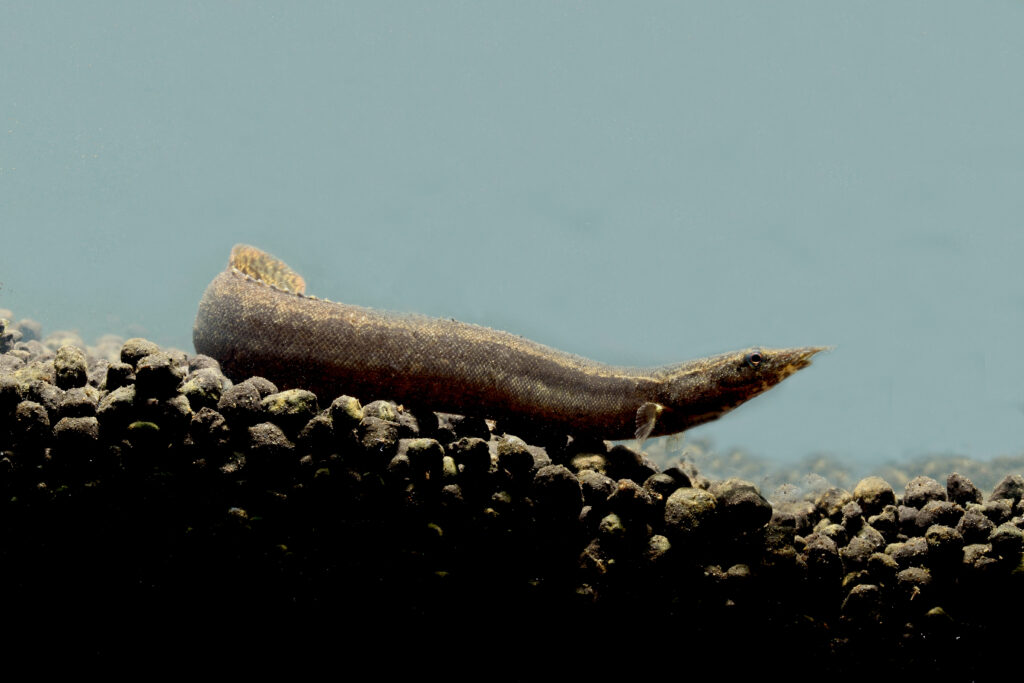
The Euphrates spiny eel has a pointed snout and darker banding all along the length of its body.
©Vince Adam/Shutterstock.com
6. Starry Puffer
Did you know a coral reef is located off the shores of Iraq? It wasn’t until 2013/2014 that researchers confirmed the finding of a coral reef in Iraq. Because the waters off the coast of Iraq are so turbid and have a wide range of temperatures, it was thought that it would be unlikely for a coral reef to exist. Now, researchers have found a 28 km² reef system that includes a variety of spectacular fish.
The starry puffer is one of the most spectacular fish found in Iraq. It has the ability to puff itself up like a balloon. They suck in water to puff up their body, making them look bigger and more intimidating. The starry puffer is one of the largest pufferfish and can reach nearly 4 feet in length, although 40 inches is more common. They are orangish to brownish with dark spots all over. If you watch one swim, you can understand why they have a reputation for being a bit tipsy. They float along using their pectoral fins to keep them from tipping too far one way or the other. Quite a sight!
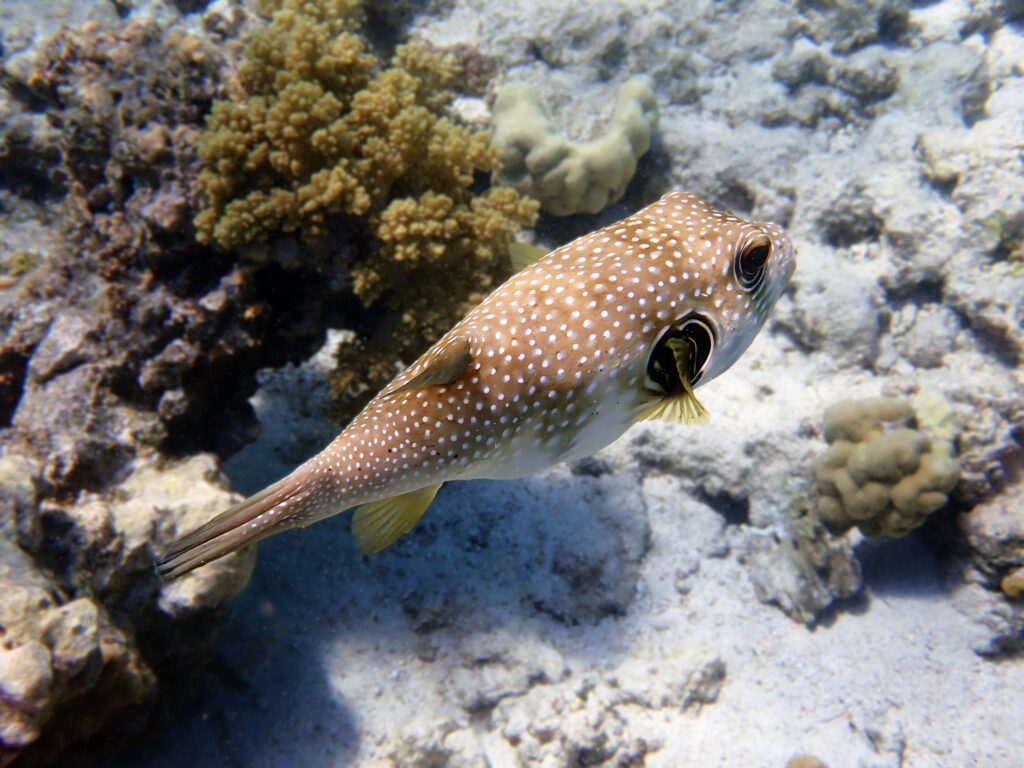
The starry puffer is one of the most spectacular fish found in Iraq. It has the ability to puff itself up like a balloon.
©Vojce/Shutterstock.com
7. Honeycomb Moray Eel
The Honeycomb moray eel is a sea eel that lives in the Persian Gulf and around the coral reef. Can you believe the honeycomb moray can get to be 9.8 feet long? These impressive eels have a distinct dark brown honeycomb pattern with a lighter background color. Their dorsal fin matches their body with a continuing pattern. They wind their way through reefs and seagrass beds, hunting for fish, mollusks, and even octopuses. Honeycomb moray eels are solitary animals and pretty territorial. They will fight each other to defend their space, which is quite a spectacle to see.
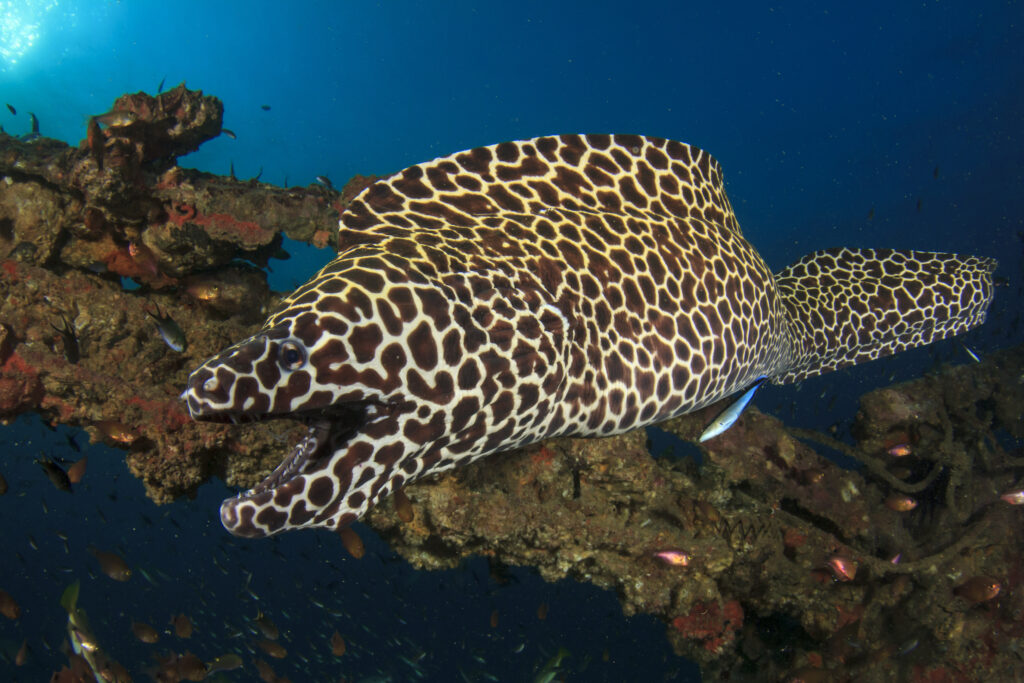
The Honeycomb moray eels have a distinct dark brown honeycomb pattern with a lighter background color.
©Rich Carey/Shutterstock.com
8. Arabian Angelfish
One of the colorful fish that can be found in Iraq is the Arabian angelfish, a marine fish that you can find swimming amongst the coral reef in the Persian Gulf. Arabian Angelfish are dark blue to black with a bright yellow vertical stripe down the center of their body and a matching yellow tail. Angelfish have a bit of a diamond-shaped body with the head coming to a point. The dorsal and anal fin come to a thin point behind the body in a crescent shape. Arabian Angelfish can get to be around 16 inches long. Being laterally compressed helps them swim through some tight spots and be able to hide from other predators. The bright yellow markings are really what make this one of the most spectacular fish found in Iraq!
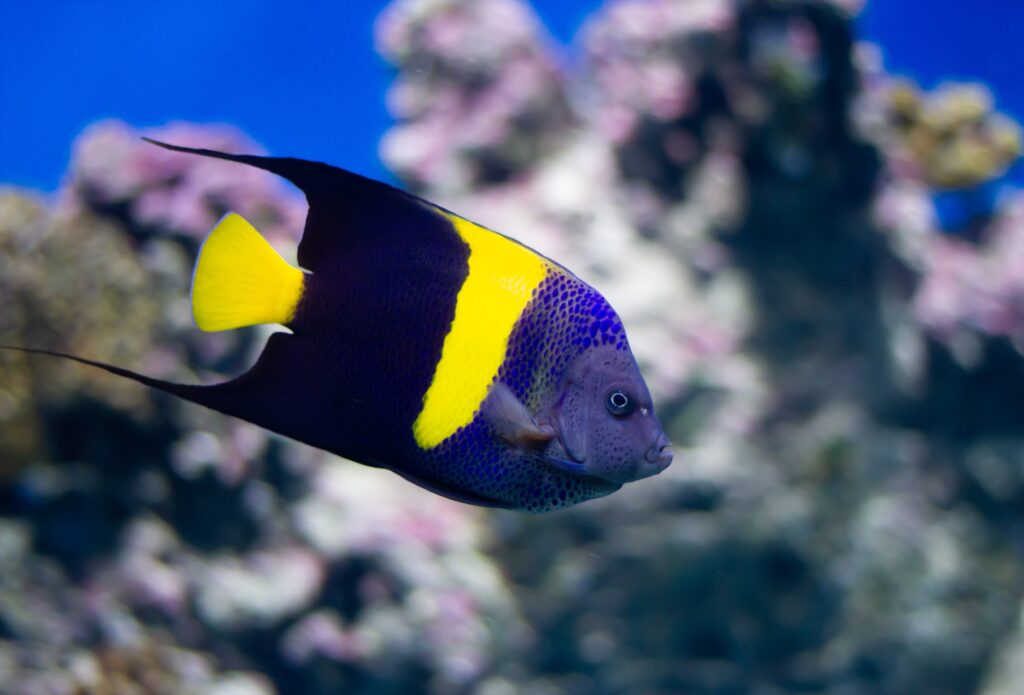
Arabian Angelfish are dark blue to black with a bright yellow vertical stripe down the center of their body and a matching yellow tail.
©Vitaly Ilyasov/Shutterstock.com
The photo featured at the top of this post is © PAUL ATKINSON/Shutterstock.com
Thank you for reading! Have some feedback for us? Contact the AZ Animals editorial team.







